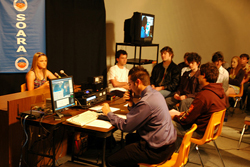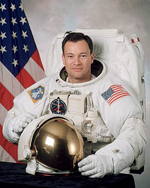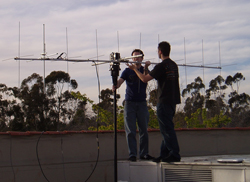 “NA1SS, this is K6UCI, do you copy?” Matt Bennett, an undergraduate mechanical and aerospace engineering student, asked over the radio.
“NA1SS, this is K6UCI, do you copy?” Matt Bennett, an undergraduate mechanical and aerospace engineering student, asked over the radio.
“Loud and clear! How about me?” Astronaut Michael Lopez-Alegria replied. Bennett and his team breathed a sigh of relief as the
Bennett, along with his team of 11 UCI Satellite Project and K6UCI Amateur Radio Club members, and 20 students from
Lopez-Alegria, a 1976 graduate of 
It was through ARISS that Bennett connected with
“We’ve never spoken to an astronaut in orbit before, so this was exciting,” said Bennett, the lead assistant in organizing the radio link. “It was an honor, especially because Lopez-Alegria is such a prestigious astronaut who holds a world record for space operations.”
Lopez-Alegria, who has been an astronaut since the early 1990s, holds the American record for the most spacewalks and the total time spent on spacewalks. He has been on 10 spacewalks for a total of more than 67 hours.
Bennett and his team spent more than 16 hours before contact organizing and setting-up the equipment: a 16-foot-long beam antenna; an RF amplifier; a computer-controlled antenna rotator; and a computer with specific software to track and point the antenna at the ISS. To prevent a loss of contact due to equipment failure, redundant radios, backup antennas, and power supplies were also installed. 
The ISS only passes a particular area on Earth a few times per day, at a velocity of 7.7 km/s, or about 17,224 mph, at an average altitude of 330 km, or about 205 miles. While Bennett’s team could only maintain contact with the ISS for a matter of minutes each pass of the space station in orbit, NASA maintains constant contact with the station using strategically placed ground stations around the world and their Tracking and Data Relay Satellite network.
Due to the small window of opportunity to connect with the ISS, the system had to be precisely calibrated and failure tested before contact. To maintain contact with the ISS, the antenna rotator had to constantly point the beam antenna directly at the ISS. Bennett also had to calculate and adjust for the Doppler Effect - the same effect that makes the pitch of a passing car holding its horn go from high to low as it moves past - as the station moved in orbit.
 The
The
The participating high school students had 13 of their 20 pre-approved questions answered, and more than 400 people around the world tuned in to the live Internet audio stream of the interview.
